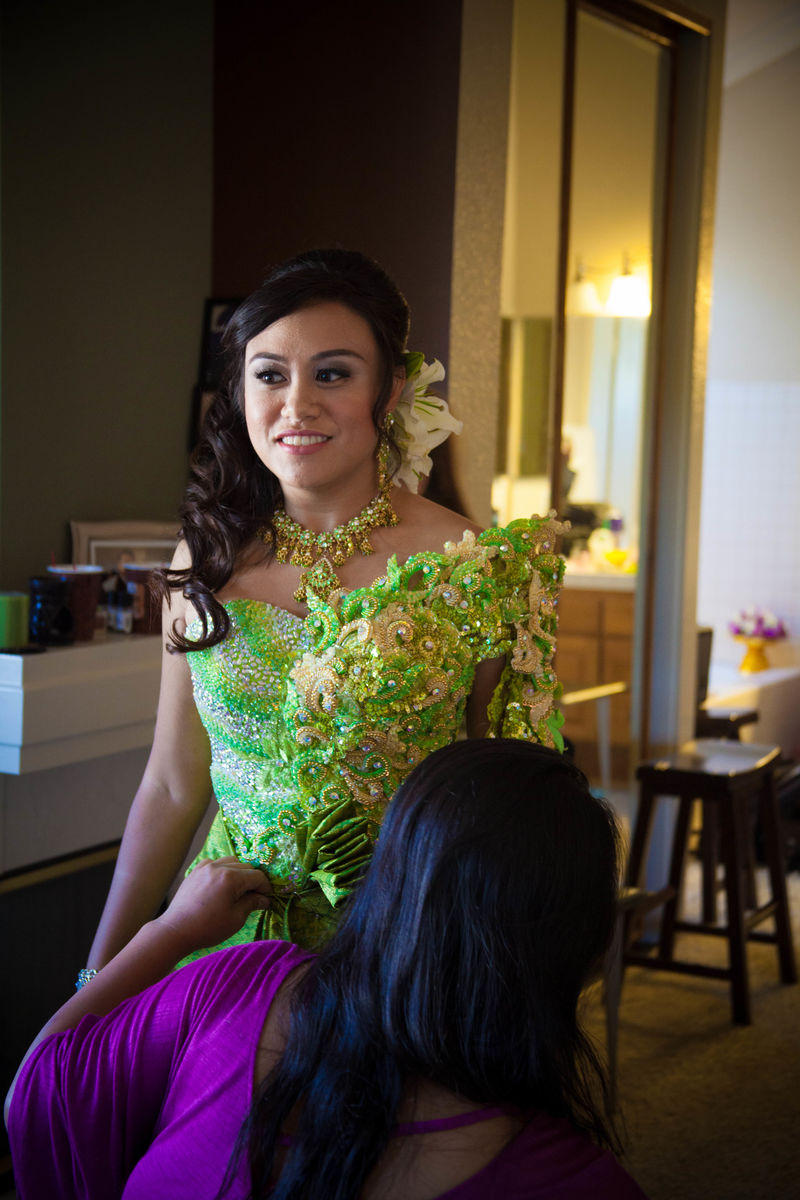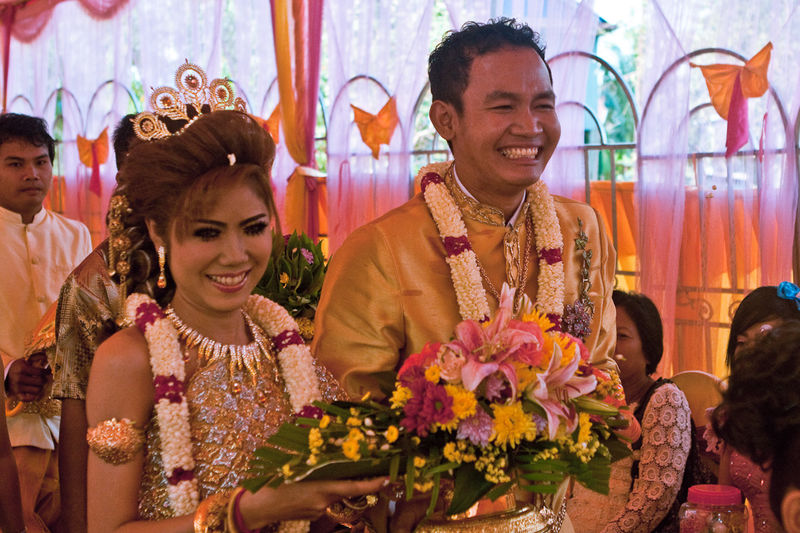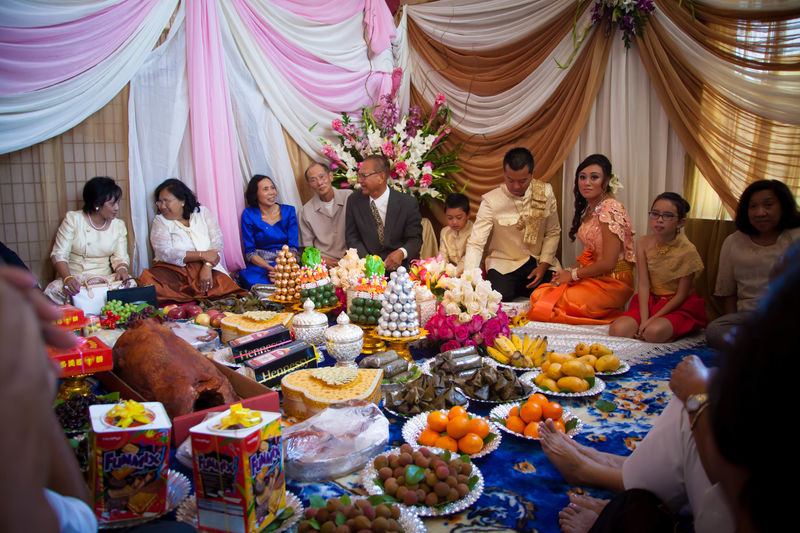Cambodian Wedding
Cambodian weddings, deeply rooted in tradition, start with an arranged proposal and feature a seven-part ceremony that includes ancestral honors, monk blessings, and symbolic rituals like hair cutting and knot tying. The celebrations, which reflect rich cultural heritage, occur at the bride's home and conclude with the couple living with the bride's parents, adhering to customs that emphasize familial ties.
Cambodian Wedding Traditions
Cambodia is a country in the southeast of Asia. Some 90% of population are the Khmers. Over 95% Cambodians are Theravada Buddhists.
Arranged marriages where parents play a key figure still dominate in local villages. The help of a matchmaker is often required. Some communities do not have weddings during rainy season.
According to an old Khmer belief people can marry only in the months that have 30 days. Within these months there are only 7 days favourable for the wedding. Weddings can not be held on the birthday of either bride or groom, religious holidays, Khmer New Year etc. On the other side engagement ceremonies can be held during whole year.

In the past a wedding lasted three days. Nowadays the wedding is held during a day and then the next night.
The couple is dressed in silk clothes. A bride wears a traditional "sampot" ("sarong") dress and numerous jewellery. A groom wears a jacket and trousers. The couple can change the clothes several times as each ceremony requires its own colour.
The couple has several bridesmaids and groomsmen. During almost all wedding ceremonies everyone sits or kneels.
The wedding is guided by the master of ceremonies. His or her actions are always fill with humour. It is common that guests are encouraged to actively participate in the events.
A traditional Cambodian wedding has seven parts. It is believed that these parts have their origin in an ancient legend about the wedding of prince Preah Thong and princess and princess Neang Neak. Wedding ceremonies are usually held in the bride's home.

"Hai Goan Gomloh" is a tradtional visit of a groom-to-be and his family members to the home of a bride-to-be. He brings various presents. If someone else wishes to join them he or she will get a silver tray with some fruits or a present.
"Sien Doan Taa" is a tradition that honours family ancestors. People bow, bring lit incense, various food and tea in front of the family altar. This tradition is also held on other imporatant family occassions.
Some monks arrive. They chant and bless the couple and close family members with some scented water. This is known as "Soat Mun".
During a cleansing ritual called "Gaat Sah" a man and a woman perform a symbolic haircut and sprinkling of perfume over the couple. After that the couple's parents can do the same. "Gaat Sah" represents leaving an old life of individuals and starting a new life of two human beings.
A bride and groom honour their parents in the ceremony called "Bang Chhat Madaiy". They do it so by holding golden yellow parasols over their parents. A wedding host gives a speach in which he emphasizes the couple's new duty to take care of their parents.
The sixth part of the Cambodian wedding is "Bongvul Pbopul". Several married couples from the local community surround and bless a bride and groom.
The wedding ends with "Sompeas Ptem" ritual. Just before its beggining people walk around the area where it will be held. A groom carries a sword and protects a bride.
"Sompeas Ptem" ritual is known as a special knot tying ritual. This knot symbolizes the newly created bond between two people. The couple kneels and holds a sword.
People come towards the couple and tie red strings to bride's and groom's wrists. They can use the occasion to wish the couple all the best, bless them or give them some money as a present.
"Sompeas Ptem" ritual ends when the people throw white plam seeds called "pka sla" at the newlyweds.

In front of the couple people there is lot of fruit and various dishes served on golden or silver plates. The venue of the wedding is decorated with numerous beautiful flower arrangements and candles.
The same as all over the World music is a very important part of every wedding. One of the most famous wedding songs is "Phat Cheay".
After the wedding couple traditionally lives with bride's parents. This can be only temporarily. One tradition is a must. A groom should do his best in helping his father-in-law.
References
Cambodia
https://en.wikipedia.org/wiki/Cambodia
The Seven Circles of Fire: Cambodian Wedding Traditions
http://cambodiangecko.com/cambodian-wedding-traditions/
Traditional Cambodian (Khmer) Wedding Ceremonies
https://pairedlife.com/relationships/Traditional-Cambodian-Khmer-Wedding-Ceremonies
Khmer Wedding
http://www.tourismcambodia.com/culture/art-and-culture/khmer-wedding.htm
Courtship, marriage, and divorce in Cambodia
https://en.wikipedia.org/wiki/Courtship,_marriage,_and_divorce_in_Cambodia
Marriage, Weddings and Divorce in Cambodia
http://factsanddetails.com/southeast-asia/Cambodia/sub5_2c/entry-2884.html
image(s)
Cambodian bride (photo by Sodanie Chea, Flickr)
https://www.flickr.com/photos/sodaniechea/7841936504
Cambodian bride and groom (photo by Vandenn, Flickr)
https://www.flickr.com/photos/vandenn/4424211142/
Cambodian wedding (photo by Sodanie Chea, Flickr)
https://www.flickr.com/photos/sodaniechea/7841927862